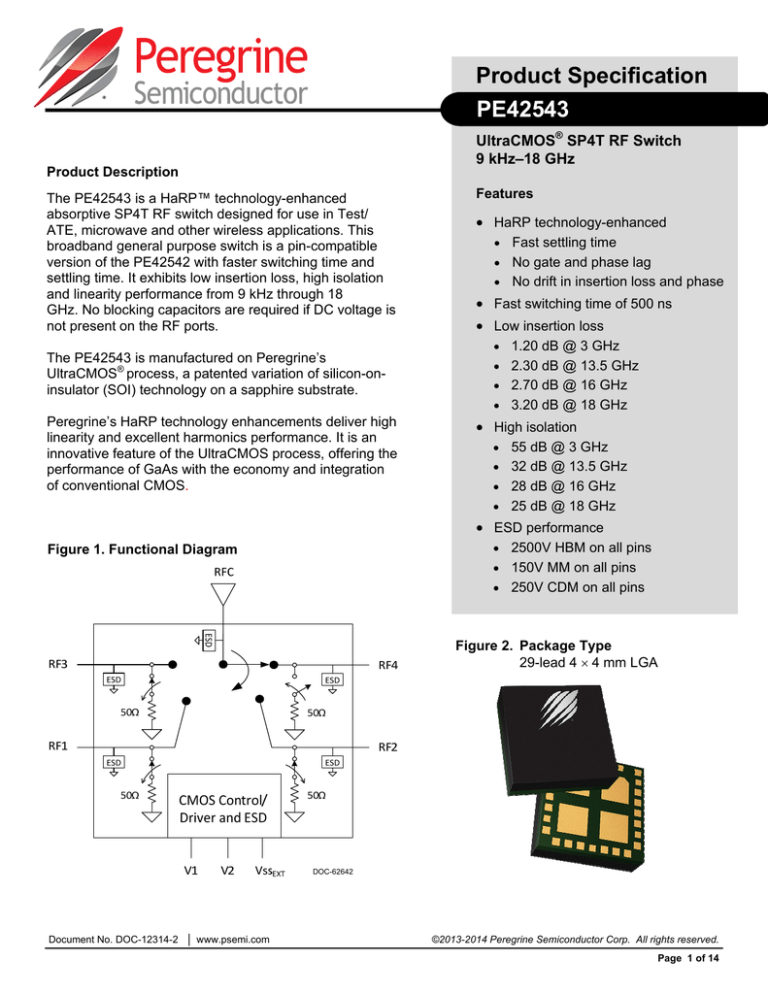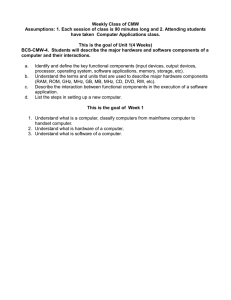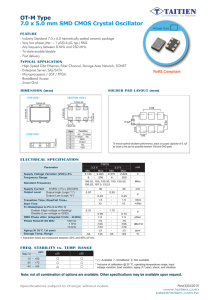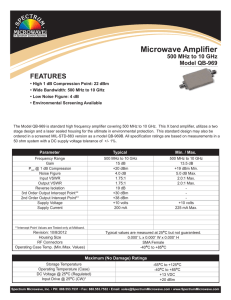
Product Specification
PE42543
UltraCMOS® SP4T RF Switch
9 kHz–18 GHz
Product Description
The PE42543 is a HaRP™ technology-enhanced
absorptive SP4T RF switch designed for use in Test/
ATE, microwave and other wireless applications. This
broadband general purpose switch is a pin-compatible
version of the PE42542 with faster switching time and
settling time. It exhibits low insertion loss, high isolation
and linearity performance from 9 kHz through 18
GHz. No blocking capacitors are required if DC voltage is
not present on the RF ports.
The PE42543 is manufactured on Peregrine’s
UltraCMOS® process, a patented variation of silicon-oninsulator (SOI) technology on a sapphire substrate.
Peregrine’s HaRP technology enhancements deliver high
linearity and excellent harmonics performance. It is an
innovative feature of the UltraCMOS process, offering the
performance of GaAs with the economy and integration
of conventional CMOS.
Features
HaRP technology-enhanced
Fast settling time
No gate and phase lag
No drift in insertion loss and phase
Fast switching time of 500 ns
Low insertion loss
1.20 dB @ 3 GHz
2.30 dB @ 13.5 GHz
2.70 dB @ 16 GHz
3.20 dB @ 18 GHz
High isolation
55 dB @ 3 GHz
32 dB @ 13.5 GHz
28 dB @ 16 GHz
25 dB @ 18 GHz
ESD performance
2500V HBM on all pins
Figure 1. Functional Diagram
150V MM on all pins
250V CDM on all pins
Figure 2. Package Type
29-lead 4 4 mm LGA
DOC-62642
Document No. DOC-12314-2 │ www.psemi.com
©2013-2014 Peregrine Semiconductor Corp. All rights reserved.
Page 1 of 14
PE42543
Product Specification
Table 1. Electrical Specifications @ 25°C (ZS = ZL = 50Ω ), unless otherwise noted
Normal Mode1: VDD = 3.3V, VSS_EXT = 0V or Bypass Mode2: VDD = 3.4V, VSS_EXT = –3.4V
Parameter
Path
Condition
Min
Operating frequency
Typ
9k
0.70
1.20
1.65
2.10
2.30
2.70
3.20
Max
Unit
18 G
Hz
0.85
1.50
2.05
2.55
2.80
3.20
3.90
dB
dB
dB
dB
dB
dB
dB
RFC–RFX
9 kHz–10 MHz
10–3000 MHz
3000–7500 MHz
7500–10000 MHz
10000–13500 MHz
13500–16000 MHz
16000–18000 MHz
RFX–RFX
9 kHz–10 MHz
10–3000 MHz
3000–7500 MHz
7500–10000 MHz
10000–13500 MHz
13500–16000 MHz
16000–18000 MHz
80
53
46
41
36
31
27
90
55
48
43
38
33
29
dB
dB
dB
dB
dB
dB
dB
Isolation
RFC–RFX
9 kHz–10 MHz
10–3000 MHz
3000–7500 MHz
7500–10000 MHz
10000–13500 MHz
13500–16000 MHz
16000–18000 MHz
78
54
41
36
31
27
24
90
55
42
38
32
28
25
dB
dB
dB
dB
dB
dB
dB
Return loss
(active and common port)
RFC–RFX
9 kHz–10 MHz
10–3000 MHz
3000–18000 MHz
22
15
14
dB
dB
dB
RFX
9 kHz–18000 MHz
14
dB
Fig. 4
dBm
Insertion loss
Isolation
Return loss
(terminated port)
Input 0.1dB compression point3
RFC–RFX
Input IP2
RFC–RFX
10–18000 MHz
113
dBm
Input IP3
RFC–RFX
10–18000 MHz
59
dBm
Settling time
50% CTRL to 0.05 dB final value
2
3
µs
Switching time
50% CTRL to 90% or 10% of final value
500
800
ns
Notes: 1. Normal mode: connect VSS_EXT (pin 29) to GND (VSS_EXT = 0V) to enable internal negative voltage generator.
2. Bypass mode: use VSS_EXT (pin 29) to bypass and disable internal negative voltage generator.
3. The input 0.1dB compression point is a linearity figure of merit. Refer to Table 3 for the RF input power PMAX (50Ω).
©2013-2014 Peregrine Semiconductor Corp. All rights reserved.
Page 2 of 14
Document No. DOC-12314-2 │ UltraCMOS® RFIC Solutions
PE42543
Product Specification
Figure 3. Pin Configuration (Top View)
Table 3. Operating Ranges
Symbol
Min
Supply voltage
VDD
2.3
Supply current
IDD
Parameter
Typ
Max
Unit
5.5
V
120
200
uA
3.4
5.5
V
50
80
uA
–3.2
V
1
Normal mode (VSS_EXT = 0V)
2
Bypass mode (VSS_EXT = –3.4V)
Supply voltage
(VDD ≥ 3.4V for Table 1
full spec. compliance)
VDD
Supply current
IDD
2.7
Negative supply voltage
VSS_EXT
–3.6
Negative supply current
ISS
–40
Digital input high
(V1, V2)
VIH
1.17
3.6
V
Digital input low
(V1, V2)
VIL
–0.3
0.6
V
Fig. 4
30
dBm
dBm
Fig. 4
32
dBm
dBm
Fig. 4
20
dBm
dBm
+85
°C
–16
uA
Normal or Bypass mode
Table 2. Pin Descriptions
Pin #
Pin
Name
Description
1, 3–6, 8–11,
13–16,
18–21, 23,
25, 26
GND
Ground
2
RF21
RF port 2
7
1
RF4
RF port 4
12
RFC1
RF common
17
RF31
RF port 3
22
1
RF1
RF port 1
24
VDD
Supply voltage (nominal 3.3V)
27
V2
Digital control logic input 2
28
V1
Digital control logic input 1
29
VSS_EXT2
Pad
GND
RF input power,
CW (RFC–RFX)3
9 kHz–27.5 MHz
≥ 27.5 MHz–18 GHz
PMAX,CW
RF input power, pulsed
(RFC–RFX)4
9 kHz–27.5 MHz
≥ 27.5 MHz–18 GHz
PMAX,PULSED
RF input power into
terminated ports, CW
(RFX)3
9 kHz–18.8 MHz
≥ 18.8 MHz–18 GHz
PMAX,TERM
Operating temperature
range
TOP
–40
+25
Notes: 1. Normal mode: connect VSS_EXT (pin 29) to GND (VSS_EXT = 0V) to
enable internal negative voltage generator
2. Bypass mode: use VSS_EXT (pin 29) to bypass and disable internal
negative voltage generator
3. 100% duty cycle, all bands, 50Ω
4. Pulsed, 5% duty cycle of 4620 µs period, 50Ω
External VSS negative voltage control
Exposed pad: Ground for proper operation
Notes: 1. RF pins 2, 7, 12, 17, and 22 must be at 0 VDC. The RF pins do not
require DC blocking capacitors for proper operation if the 0 VDC
requirement is met.
2. Use VSS_EXT (pin 29) to bypass and disable internal negative voltage
generator. Connect VSS_EXT (pin 29) to GND (VSS_EXT = 0V) to enable
internal negative voltage generator.
Document No. DOC-12314-2 │ www.psemi.com
©2013-2014 Peregrine Semiconductor Corp. All rights reserved.
Page 3 of 14
PE42543
Product Specification
Table 4. Absolute Maximum Ratings
Parameter/Condition
Supply voltage
Digital input voltage (V1, V2)
Symbol
Min
Max
Unit
VDD
–0.3
5.5
V
VCTRL
–0.3
3.6
V
Fig. 4
33
dBm
dBm
Fig. 4
34
dBm
dBm
RF input power, CW
(RFC–RFX)1
9 kHz–27.5 MHz
≥ 27.5 MHz–18 GHz
PMAX,ABS
RF input power, pulsed
(RFC–RFX)2
9 kHz–27.5 MHz
≥ 27.5 MHz–18 GHz
PMAX,PULSED
RF input power into
terminated ports, CW (RFX)1
9 kHz–18.8 MHz
≥ 18.8 MHz–18 GHz
Storage temperature range
3
ESD voltage HBM, all pins
4
Switching Frequency
PMAX,TERM
TST
–65
VESD,HBM
Fig. 4
22
dBm
dBm
+150
°C
2500
V
ESD voltage MM , all pins
VESD,MM
150
V
ESD voltage CDM5, all pins
VESD,CDM
250
V
Notes:
1. 100% duty cycle, all bands, 50Ω
2. Pulsed, 5% duty cycle of 4620 µs period, 50Ω
3. Human Body Model (MIL_STD 883 Method 3015)
4. Machine Model (JEDEC JESD22-A115)
5. Charged Device Model (JEDEC JESD22-C101)
Exceeding absolute maximum ratings may cause
permanent damage. Operation should be
restricted to the limits in the Operating Ranges
table. Operation between operating range
maximum and absolute maximum for extended
periods may reduce reliability.
Electrostatic Discharge (ESD) Precautions
When handling this UltraCMOS device, observe
the same precautions that you would use with
other ESD-sensitive devices. Although this device
contains circuitry to protect it from damage due to
ESD, precautions should be taken to avoid
exceeding the rating specified.
The PE42543 has a maximum 25 kHz switching
rate when the internal negative voltage generator
is used (pin 29 = GND). Switching frequency
describes the time duration between switching
events. Switching time is the duration between
the point the control signal reaches 50% of the
final value and the point the output signal reaches
within 10% or 90% of its target value.
Optional External VSS Control (VSS_EXT)
For proper operation, the VSS_EXT control pin must
be grounded or tied to the VSS voltage specified in
Table 3. When the VSS_EXT control pin is
grounded, FETs in the switch are biased with an
internal negative voltage generator. For
applications that require the lowest possible spur
performance, VSS_EXT can be applied externally to
bypass the internal negative voltage generator.
Spurious Performance
The typical spurious performance of the PE42543
is –150 dBm when VSS_EXT = 0V (pin 29 = GND). If
further improvement is desired, the internal
negative voltage generator can be disabled by
setting VSS_EXT = –3.4V.
Table 5. Truth Table
State
V1
V2
RF1 on
0
0
RF2 on
1
0
RF3 on
0
1
RF4 on
1
1
Moisture Sensitivity Level
Latch-Up Avoidance
The Moisture Sensitivity Level rating for the
PE42543 in the 29-lead 4 4 mm LGA package is
MSL3.
Unlike conventional CMOS devices, UltraCMOS
devices are immune to latch-up.
Hot-Switching Capability
The maximum hot switching capability of the
PE42543 is 20 dBm from 18.8 MHz to 18 GHz.
The maximum hot switching capability below
18.8 MHz does not exceed the maximum RF CW
terminated power, see Figure 4. Hot switching
occurs when RF power is applied while switching
between RF ports.
©2013-2014 Peregrine Semiconductor Corp. All rights reserved.
Page 4 of 14
Document No. DOC-12314-2 │ UltraCMOS® RFIC Solutions
PE42543
Product Specification
Figure 4a. Power De-rating Curve for 9 kHz–18 GHz @ 25°C Ambient (50Ω)
35
30
Input Power (dBm)
25
20
15
10
P0.1 dB Compression @ 25°C Ambient
Max. RF Input Power, Pulsed (≥ 26.0 MHz, 25°C Ambient)
5
Max. RF Input Power, CW (≥ 26.0 MHz, 25°C Ambient)
Max. RF Input Power, CW & Pulsed (< 26.0 MHz, 25°C Ambient)
0
Max. RF Terminated Power, CW @ 25°C Ambient
‐5
Frequency (MHz)
Figure 4b. Power De-rating Curve for 9 kHz–18 GHz @ 85°C Ambient (50Ω)
35
30
Input Power (dBm)
25
20
15
10
P0.1 dB Compression @ 85°C Ambient
Max. RF Input Power, Pulsed (≥ 27.5 MHz, 85°C Ambient)
5
Max. RF Input Power, CW (≥ 27.5 MHz, 85°C Ambient)
Max. RF Input Power, CW & Pulsed (< 27.5 MHz, 85°C Ambient)
0
Max. RF Terminated Power, CW @ 85°C Ambient
‐5
Frequency (MHz)
Document No. DOC-12314-2 │ www.psemi.com
©2013-2014 Peregrine Semiconductor Corp. All rights reserved.
Page 5 of 14
PE42543
Product Specification
Typical Performance Data @ 25°C and VDD = 3.3V (ZS = ZL = 50Ω ), unless otherwise noted
Figure 5. Insertion Loss (RFC–RFX)
Figure 6. Insertion Loss vs. Temp (RFC–RFX)
©2013-2014 Peregrine Semiconductor Corp. All rights reserved.
Page 6 of 14
Figure 7. Insertion Loss vs. VDD (RFC–RFX)
Document No. DOC-12314-2 │ UltraCMOS® RFIC Solutions
PE42543
Product Specification
Typical Performance Data @ 25°C and VDD = 3.3V (ZS = ZL = 50Ω ), unless otherwise noted
Figure 8. RFC Port Return Loss vs. Temp
Figure 9. RFC Port Return Loss vs. VDD
Figure 10. Active Port Return Loss vs. Temp
Figure 11. Active Port Return Loss vs. VDD
Document No. DOC-12314-2 │ www.psemi.com
©2013-2014 Peregrine Semiconductor Corp. All rights reserved.
Page 7 of 14
PE42543
Product Specification
Typical Performance Data @ 25°C and VDD = 3.3V (ZS = ZL = 50Ω ), unless otherwise noted
Figure 12. Terminated Port Return Loss vs. Temp
©2013-2014 Peregrine Semiconductor Corp. All rights reserved.
Page 8 of 14
Figure 13. Terminated Port Return Loss vs. VDD
Document No. DOC-12314-2 │ UltraCMOS® RFIC Solutions
PE42543
Product Specification
Typical Performance Data @ 25°C and VDD = 3.3V (ZS = ZL = 50Ω ), unless otherwise noted
Figure 14. Isolation vs. Temp (RFX–RFX)*
Figure 15. Isolation vs. VDD (RFX–RFX)*
Note: * RF1 adjacent to RF3
RF2 adjacent to RF4
RF1 and RF3 opposite to RF2 and RF4
Document No. DOC-12314-2 │ www.psemi.com
©2013-2014 Peregrine Semiconductor Corp. All rights reserved.
Page 9 of 14
PE42543
Product Specification
Typical Performance Data @ 25°C and VDD = 3.3V (ZS = ZL = 50Ω ), unless otherwise noted
Figure 16. Isolation vs. Temp
(RFC–RFX, RF1 or RF2 Active)*
Figure 17. Isolation vs. VDD
(RFC–RFX, RF1 or RF2 Active)*
Figure 18. Isolation vs. Temp
(RFC–RFX, RF3 or RF4 Active)*
Figure 19. Isolation vs. VDD
(RFC–RFX, RF3 or RF4 Active)*
Note: * RF1 adjacent to RF3
RF2 adjacent to RF4
RF1 and RF3 opposite to RF2 and RF4
©2013-2014 Peregrine Semiconductor Corp. All rights reserved.
Page 10 of 14
Document No. DOC-12314-2 │ UltraCMOS® RFIC Solutions
PE42543
Product Specification
Evaluation Kit
Figure 20. Evaluation Board Layout
The SP4T switch evaluation board was designed
to ease customer evaluation of Peregrine’s
PE42543. The RF common port is connected
through a 50Ω transmission line via the SMA
connector, J1. RF1, RF2, RF3 and RF4 ports are
connected through 50Ω transmission lines via
SMA connectors J4, J3, J2 and J5, respectively.
A 50Ω through transmission line is available via
SMA connectors J6 and J7, which can be used to
de-embed the loss of the PCB. J13 provides DC
and digital inputs to the device.
The board is constructed of a four metal layer
material with a total thickness of 62 mils. The top
RF layer is Rogers 4360 material with a thickness
of 32 mils and the r = 6.4. The middle layers
provide ground for the transmission lines. The
transmission lines were designed using a
coplanar waveguide with ground plane model
using a trace width of 18 mils, trace gaps of 7 mils
and metal thickness of 2.1 mils.
For the true performance of the PE42543 to be
realized, the PCB should be designed in such a
way that RF transmission lines and sensitive DC
I/O traces are heavily isolated from one another.
High frequency insertion loss and return loss can
be further improved by external series inductive
tuning traces in the customer application board
layout. For example, to improve 12–18 GHz
performance, use ~180 pH for RFX ports and
~50 pH for RFC port.
PRT-09205
Vector de-embed is recommended to more
accurately calculate the performance of the
DUT. Refer to Application Note 39 “Vector Deembedding of the PE42542 and PE42543 SP4T
RF Switches” for additional information. The half
thru line data file can be downloaded from
Peregrine’s website to facilitate the vector deembedding.
Document No. DOC-12314-2 │ www.psemi.com
©2013-2014 Peregrine Semiconductor Corp. All rights reserved.
Page 11 of 14
PE42543
Product Specification
Figure 21. Evaluation Board Schematic
J13
VDD
R6
DNI
R8
0 OHM
R7
0 OHM
R1
DNI
R2
DNI
R3
DNI
R4
DNI
1
3
5
7
9
11
13
1
3
5
7
9
11
13
2
4
6
8
10
12
14
2
4
6
8
10
12
14
R5
PE42543
GND
RF1
GND
GND
GND
GND
RF3
GND
50 OHM
23
22
21
20
19
18
17
16
GND
GND
GND
GND
VSS 29
V1 28
V2 27
GND
RF2
GND
GND
GND
GND
RF4
GND
U1
50 OHM
C3
C4
C5
C6
DNI
DNI
DNI
DNI
J4
J2
J7
C7
DNI
50 OHM
J6
30
31
32
33
50 OHM
1
2
3
4
5
6
7
8
9
10
11
12
13
14
15
J5
50 OHM
GND
GND
GND
RFC
GND
GND
GND
J3
TMGND 26
DGND 25
VDD 24
DNI
THRU
J1
50 OHM
DOC-12327
CAUTION: Contains parts and assemblies susceptible to damage by electrostatic discharge (ESD).
©2013-2014 Peregrine Semiconductor Corp. All rights reserved.
Page 12 of 14
Document No. DOC-12314-2 │ UltraCMOS® RFIC Solutions
PE42543
Product Specification
Figure 22. Package Drawing
29-lead 4 4 mm LGA
A
PIN #1 CORNER
4.00
(2X)
B
0.26x0.30
(x6)
0.20 x45°
Chamfer
0.40
(x5)
0.40
0.33x0.34
(x18)
0.4684
0.4684
0.4284
0.30x0.30
(x5)
0.4284
0.4484
0.4484
0.4484
4.00
0.4484
0.4484
1.13
(x4)
1.13
(x4)
0.24
(x4)
0.24
(x4)
0.4684
0.4284
3.80
0.4484
1.13
0.4684
1.13
0.4284
0.4646
0.10
(x29)
(2X)
0.4948
0.4484
0.24
(x4)
3.80
0.4684
0.70±0.05
0.91±0.10
0.4684
0.24
(x4)
RECOMMENDED LAND PATTERN
BOTTOM VIEW
TOP VIEW
0.4484
Note:
- Dimensions concerning Pad pitch are all
mirrored across the Y-axis
DOC-50743
SEATING PLANE
SIDE VIEW
C
Figure 23. Top Marking Specification
42543
YYWW
ZZZZZ
= Pin 1 designator
YYWW = Date code, last two digits of assembly year and work week
ZZZZZ = Last five characters of the assembly lot code
DOC-51207-2
Document No. DOC-12314-2 │ www.psemi.com
©2013-2014 Peregrine Semiconductor Corp. All rights reserved.
Page 13 of 14
PE42543
Product Specification
Figure 24. Tape and Reel Drawing
Table 6. Ordering Information
Order Code
Description
Package
Shipping Method
PE42543A-X
PE42543 SP4T RF switch
29-lead 4 4 mm LGA
500 units / T&R
EK42543-02
PE42543 Evaluation kit
Evaluation kit
1 / Box
Sales Contact and Information
For sales and contact information please visit www.psemi.com.
Advance Information: The product is in a formative or design stage. The datasheet contains design target
specifications for product development. Specifications and features may change in any manner without notice.
Preliminary Specification: The datasheet contains preliminary data. Additional data may be added at a later
date. Peregrine reserves the right to change specifications at any time without notice in order to supply the best
possible product. Product Specification: The datasheet contains final data. In the event Peregrine decides to
change the specifications, Peregrine will notify customers of the intended changes by issuing a CNF (Customer
Notification Form).
The information in this datasheet is believed to be reliable. However, Peregrine assumes no liability for the use
of this information. Use shall be entirely at the user’s own risk.
©2013-2014 Peregrine Semiconductor Corp. All rights reserved.
Page 14 of 14
No patent rights or licenses to any circuits described in this datasheet are implied or granted to any third party.
Peregrine’s products are not designed or intended for use in devices or systems intended for surgical implant,
or in other applications intended to support or sustain life, or in any application in which the failure of the
Peregrine product could create a situation in which personal injury or death might occur. Peregrine assumes no
liability for damages, including consequential or incidental damages, arising out of the use of its products in
such applications.
The Peregrine name, logo, UltraCMOS and UTSi are registered trademarks and HaRP, MultiSwitch and DuNE
are trademarks of Peregrine Semiconductor Corp. Peregrine products are protected under one or more of the
following U.S. Patents: http://patents.psemi.com.
Document No. DOC-12314-2 │ UltraCMOS® RFIC Solutions



